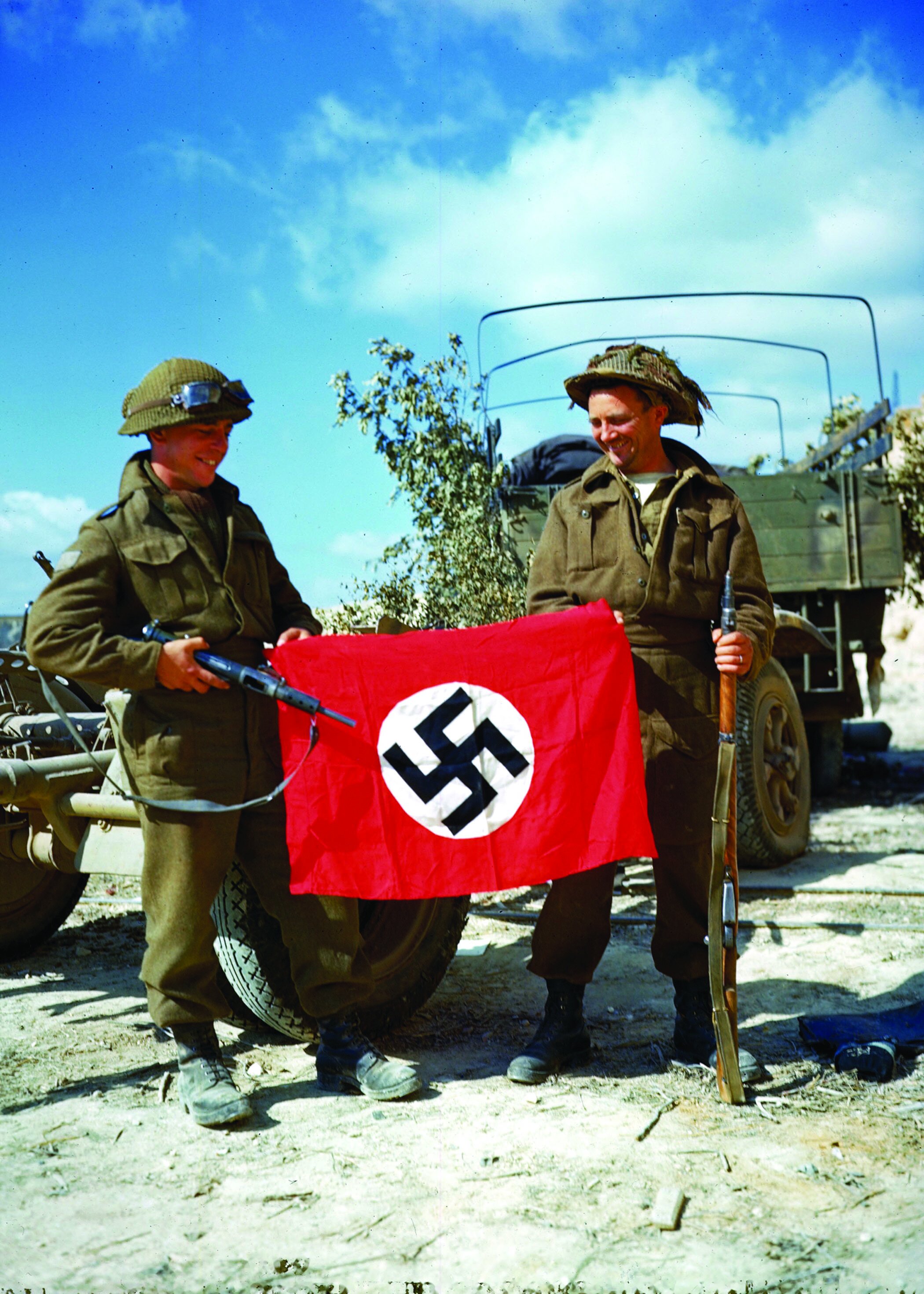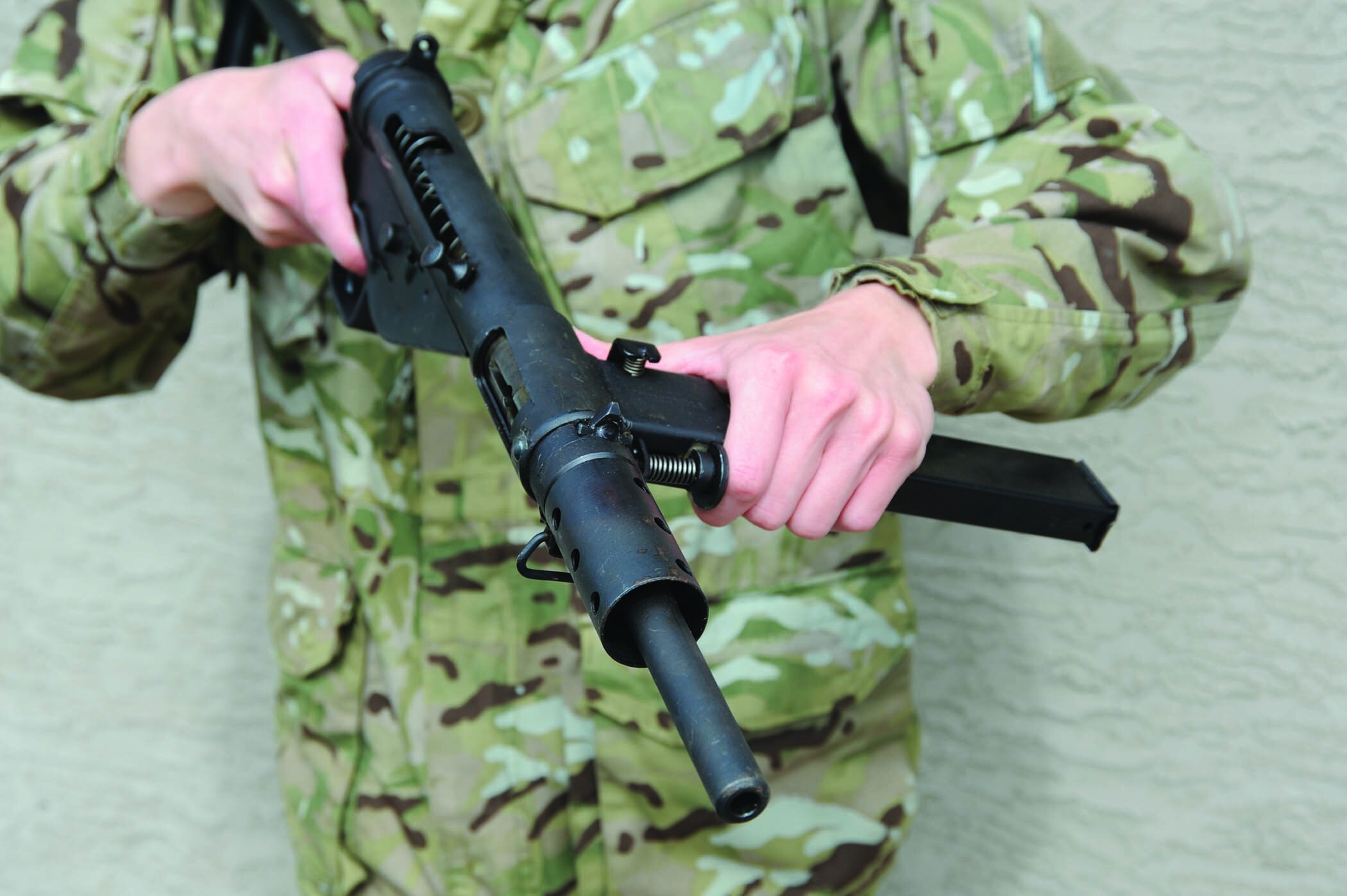by David Pugliese
IT WAS 80 YEARS AGO that Canadian troops stormed ashore at the French coastal port of Dieppe, fighting their way into the history books in what would become a brave but futile raid on Hitler’s Fortress Europe.
Almost 5,000 Canadians took part in the attack, the first Canadian Army operation in Europe. Nine hundred and sixteen were killed, thousands more were wounded or captured.
Dieppe was seen as a disaster but some historians view the Aug. 19, 1942 raid as producing valuable lessons that contributed to the success of D-Day two years later.
The Dieppe raid also marked the first time the Sten gun was used by Canadian soldiers.
But the introduction of the low-cost, easily produced 9mm submachinegun was a less than auspicious occasion. Soldiers complained about the unreliability of the Sten, marking would become a love-hate relationship with a weapon produced in the millions during the war.
Canadian troops pose with a captured Nazi flag near Hautmesnil, France on Aug. 10, 1944. The soldier on the left has a Sten gun while the other soldier is equipped with a Lee Enfield rifle. (PHOTO COURTESY LIBRARY AND ARCHIVES CANADA)
John S. Edmondson who served with the South Saskatchewan Regiment during the Second World War on the Dieppe Raid and in the Normandy campaign, provided details about the Sten in an essay published in 2004. Edmondson wrote in Canadian Military History journal that he first saw the Sten when it was issued as he and his fellow soldiers waited on the transport ships that would take them to Dieppe.
Canadian soldiers in Munderloh, Germany take time to reload Sten gun magazines in April, 1945. (PHOTO COURTESY LIBRARY AND ARCHIVES CANADA)
“On board we were issued with new Sten guns and grenades right out of the shipping crates, so they were full of grease and needed to be cleaned,” he remembered.
But there was a major problem. Since the troops were already on board their ships they couldn’t test fire their weapons to make sure they were working properly, Edmondson pointed out.
That caused trouble during fighting at Dieppe. “Rounding the corner of a building, I came face to face with a German and had my first experience using a Sten gun,” Edmondson wrote. “I pulled the trigger – a dull thud – misfire. He must have been more surprised and nervous than I was because he did not shoot. I ducked back around the corner and tried my Sten gun again, thud again. So I threw it away and picked up a rifle that someone had dropped on the ground.”
“Two years later in Normandy, I always insisted on new weapons being cleaned and fired to ensure they were in working order because your life depended on it,” Edmondson wrote.
The Sten was developed by the British as a low cost alternative to more expensive and better constructed submachineguns. The Sten, with its stamped metal parts, cost $11 while the U.S.-made Thompson submachinegun had a price tag of $70. (The Sten name is a combination of the last names of the weapon’s designers and the location of the first small arms factory it was built at – Major Reginald V. Shepherd, provided the S; Harold Turpin provide the T and the small arms location in Enfield provided the EN).
Throughout the course of the Second World War more than four million Sten guns were produced in a number of variants.
Production of Sten guns in Canada was done at the Small Arms Ltd. in Long Branch, a neighbourhood in Toronto. The federal- government owned company received its first order for Stens in August, 1941. Eventually, almost 130,000 Stens were built. Many of the guns – some 72,000 - were made for Chinese Nationalist Forces. The Imperial War Museum in London, England had one of those weapons, which bears a Chinese inscription which translates as: ‘Sten hand-carry machine-gun, Canada made’.
Interestingly, the U.S. Smithsonian National Museum of American History has in its collection a Canadian-made Long Branch Mk2 Sten from 1943.
The Sept. 18, 1943 edition of Collier’s Magazine featured an article on Canada’s Sten production at the Long Branch plant. The Canadian government allowed the Collier’s journalist access to the Sten assembly line for his article titled, “Invasion Gun”
The emphasis of the article was about the Stens being built for resistance forces in Nazi-occupied Europe. It also highlighted that the gun could be broken down into three parts for easy concealment and that each Sten sent to resistance groups was accompanied by 10 magazines.
The article also noted the Sten received its first big battle test during the Dieppe raid “and proved itself an excellent street fighting weapon.”
“Its only fault was a tendency to jam when first fired and eject the entire magazine instead of a single shot,” the article claimed. “Commandos found that a brisk bang on the cocking handle corrected this, and once the gun was heated up, the fault never returned.”
The Stens at the Long Branch plant were produced “almost entirely by women and girls from every part of Canada” – in fact three quarters of the arms factory workforce were women. “Absenteeism is negligible, for the memory of Dieppe is grim,” the article added.
“For street fighting, it is probably the best gun ever developed,” Collier’s magazine concluded.
Not everyone agreed with the description of the Sten as “the best gun ever developed” for street fighting. The gun was plagued with problems because of jams caused by its magazine.
But the weapon did have its admirers. Alan Lee of the Parachute Regiment said the Sten came into its own for use in close quarters battle. “When you went into a village or went into a house, whatever it was, it was an ideal weapon,” Lee said in a video interview released in 2013 by the National Army Museum in the United Kingdom. “It wasn’t an instrument that we used for over 100 yards. It was used for close quarter when we were clearing villages or we landed on the ground and it was close fighting.”
After the Second World War, Sten guns were deactivated by the Canadian government and sold as scrap metal or to army surplus stores where they were purchased by collectors. (PHOTO BY DAVID PUGLIESE)
After the Second World War, Canada retained the Sten in its military arsenal, issuing the weapon to troops fighting in Korea.
Korean War veteran Charles Rees, who served with 1st Battalion, Royal Canadian Regiment, praised both the Bren gun and the U.S.-made M-1 carbine but talked about how the Sten was avoided whenever possible by his fellow soldiers. “The enemy had much better weapons than what we had,” he explained in a video history compiled by Veterans Affairs Canada. “When it come to our small arms we had the rifle (and the) Sten gun, which nobody wanted to take. The spring in the magazines (was) no darn good and used to jam up the rounds,” Rees added. “So the boys did not want to take a chance (and) take one them going out on any patrols.”
In 1958, the Canadian Army replaced the Sten gun with the C1 Submachinegun. But the Sten still remained in use in the Royal Canadian Navy. A 1961 RCN manual for leading seamen and petty officers second class had instructions for use of the 9mm Sten Mk2 as well as its disassembly.
The manual described the gun as a short range weapon, equipped with a 32-round magazine, and for use against targets at ranges from 10 to 100 yards. The instructions in the manual also carried a safety warning – “If the gun is loaded do not jump with it or jar it in any other way; this may cause the breech block to drop to the rear and allow the weapon to fire.”
The Sten also found its way into other conflicts and guerilla wars after the Second World War. Israel produced its own ver- sions. The Royal Ulster Constabulary used Stens in their battles against the IRA. Some of Fidel Castro’s guerrillas were armed with the submachineguns. During the Vietnam War, U.S. special forces and long range reconnaissance teams used suppressed Sten guns on their covert missions.




